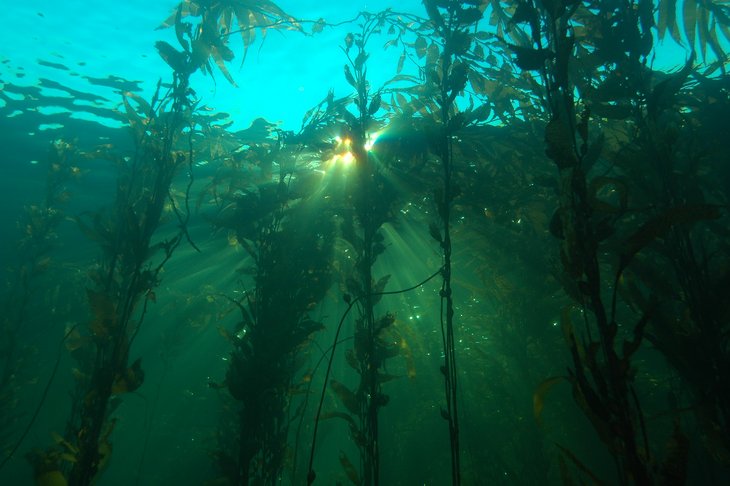
Like humans, most marine organisms need oxygen to survive. But taking in enough of it is far more challenging for life in the ocean than it is for animals on land. For one, more than 99 percent of the Earth’s available oxygen is found in the atmosphere – leaving less than one percent for the ocean and its ecosystems. In addition, ocean currents move much more slowly than air masses in the atmosphere, meaning that oxygen-rich water takes significantly longer to circulate through the oceans.
Climate-induced oxygen loss from the ocean
Throughout Earth’s history, severe oxygen loss in the oceans has triggered mass extinctions on at least three occasions. And for the past 70 years, the oceans have once again been losing oxygen. The reasons include rising sea temperatures, increasing stratification of ocean layers due to climate change, and a biological chain reaction triggered by excessive nutrient runoff from land into coastal waters. But let’s take it step by step.
The ocean plays a key role in the global oxygen cycle. At the surface, it absorbs oxygen directly from the atmosphere. This oxygen dissolves in the seawater, allowing the surface layer to reach its maximum possible oxygen content based on its temperature. The colder the water, the more oxygen it can hold. For this reason, the most oxygen-rich waters are found in the polar regions.
Conversely, the warmer the water, the less oxygen it can absorb. In other words, warm surface water struggles to take up oxygen and may even release it back into the atmosphere. This happens, for example, when water masses from the poles warm as they travel towards the tropics. But it also occurs as a direct result of ocean warming due to climate change. In warmer waters, marine organisms require more oxygen to maintain their bodily functions. Together, these two trends – higher biological demand and reduced oxygen solubility – are leading to a steady decline in oceanic oxygen levels.
Oxygen-poor zones at medium depth
When oxygen is dissolved in the surface water, wind and waves ensure a good distribution in the upper 30 to 50 metres of the water column. In the light-flooded upper 200 metres, microalgae produce additional oxygen, but this is relatively quickly reabsorbed by other organisms.
In contrast, the mid and deeper layers of the ocean rely solely on ocean currents to receive oxygen. These currents transport oxygen-rich water from the surface into the depths. However, particularly in highly productive marine regions, this supply is often no longer sufficient to meet the oxygen demands of the organisms living there. This is especially true when large amounts of biomass sink from the surface and are broken down at depth – a process that consumes even more oxygen. As a result, natural oxygen-poor zones, known as oxygen minimum zones (OMZs), develop at depths between 100 and 1,000 metres, such as off the coasts of Peru, Namibia and California. These zones pose a particular threat to predatory fish, which require large amounts of energy and oxygen to hunt. Sharks, tuna and other large predators therefore tend to avoid these areas.
Over recent decades, the number, thickness and extent of oxygen minimum zones have steadily increased. Climate-driven ocean warming and the growing influx of freshwater (from rainfall and melting sea ice) have made the layers of the ocean more stable. Surface waters are now warmer and less salty, and therefore less likely to sink. As a result, the vertical mixing of ocean layers has weakened. Circulation patterns are shifting, and deeper waters are becoming increasingly cut off from their vital oxygen supply.
Too many nutrients in coastal waters
This must be distinguished from low-oxygen zones in coastal waters, which are caused by excessive nutrient inputs, particularly in summer. Wherever fertilisers are used extensively or improperly in agriculture, rain, streams and rivers transport the excess nutrients into the coastal waters. Once there, the fertilisers promote the mass growth of microalgae. If these algae die, their biomass sinks and is decomposed by microorganisms in the water column or on the seabed. These consume so much oxygen that other marine organisms have difficulty breathing and take flight, if they are able to do so. Experts also speak of hypoxia when there is a shortage of oxygen.
Some of the largest hypoxic zones caused by nutrient overload include the so-called "dead zone" in the Gulf of Mexico and vast areas of the Baltic Sea. Researchers have now identified more than 500 coastal regions around the world where oxygen levels drop so dramatically during certain times of the year that life becomes extremely difficult – or even impossible – for oxygen-dependent marine organisms.
- World Ocean Review 07: Lebensgarant Ozean – Kapitel 2: Der Ozean im Klimawandel, Link: worldoceanreview.com/de/wor-7/der-ozean-im-klimawandel/
- Warnsignal Klima - Auswirkungen von Sauerstoffmangel auf die Artenzusammensetzung in den Meeren (2016), Link: https://www.klima-warnsignale.uni-hamburg.de/wp-content/uploads/pdf/de/biodiversitaet/warnsignal_klima-die_biodiversitaet-kapitel-2_5.pdf
- Curtis Deutsch, Justin L. Penn, and Noelle Lucey (2024). Climate, Oxygen, and the Future of Marine Biodiversity. Annual Review of Marine Science Volume 16, 2024 Vol. 16:217-245 (Volume publication date January 2024), doi.org/10.1146/annurev-marine-040323-095231








